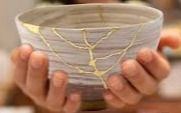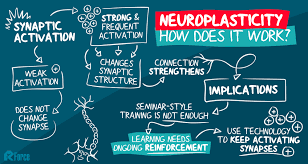
Wabi is about living in the moment, while sabi celebrates the passage of time, the way things grow and age, and how they manifest into meaningful objects. Wabi sabi embraces gentle forging of new ways of acceptance of what is, while peeling away layers and creating a positive way of understanding how to move forward from the negative. Positive Psychology uses these tools to identify and build mental assets as opposed to addressing weaknesses, and neuroplasticity is the brain's ability to change and adapt due to experience. It is an umbrella term referring to the brain's ability to change, reorganize, or grow neural networks. Martin Seligman, pioneer of positive psychology has described multiple visions of what it means to live in contentment, including:
Pleasant Life (media's view of happiness);
Good Life (focused on personal strengths and engagement);
Meaningful Life (created with substance of good intention).

Positive psychologists who implement Seligman's research further explore a variety of experiences and behaviors involved in different versions of positive living, including specific positive emotions, flow states, and sense of meaning or purpose. "Flow" is a term invented by Mihaly Csikszentmihalyi, psychologist to describe a rewarding state of immersion in an activity, such as when people create art, music, writing or play a sport they are passionate about. It has been proposed as one of the factors that contribute to contentment. When Positive Psychology, Neuroplasticity and Wabi Sabi are woven together, the results are remarkable. Kintsukroi (or golden repair) is the outcome; it treats the life-repairing process with reverence as pieces of history rather than something to disguise.
Andrew Weil, M.D. - US Physician, Writer, and alternative medicine advocate teaches that "... neuroplasticity means that emotions such as happiness and compassion can be cultivated in much the same way that a person can learn through repetition to play golf and basketball or master a musical instrument, and that such practice changes the activity and physical aspects of specific brain areas."

Santiago Ramón y Cajal considered a forefather in neuroscience spoke of “neuronal plasticity” in the early 1900s. He recognized that brains could indeed change, even in adulthood. In 1948, Polish neuroscientist Jerry Konorski coined the term neuroplasticity to describe his observation of changes in neuronal structure, referring to neurons; the cells that make up our brains. Our extraordinary brains can actually receive hardware updates in addition to software updates, creating different pathways that are created and are discarded, according to our experiences. With everything new that we learn, we create new connections between our neurons, further rewiring our brains to adapt to new situations. This occurs daily, unconsciously, and is something that we can encourage and stimulate with practice. Konorski touts that with mindful practice, you can:
Recover from brain events like strokes;
Recover from traumatic brain injuries;
Rewire functions in the brain. If an area of the brain loses function in one area, rewiring will enhance functions in other areas (e.g., if one sense is lost, the others may become heightened);
Enhance memory abilities and a wide range of cognitive abilities.
According to student of J. Konorski teachings, Dr. Abraham M. Joshua, Medical College of Mangalore, Manipal Academy of Higher Education, Manipal, India,
"Brain neuroplasticity is central for learning and memory. It allows us to respond to the changes in the environment. Neuroplasticity, a life-long process that mediates the structural and functional reaction of neuronal structures to experience, attrition, and injury, plays an imperative role in recovery. Understanding the ability of the nervous system to adapt or modify functions and compensate for damage is critical to improving rehabilitative strategies and optimizing functional outcomes. For a long time, the hardware of the brain was considered 'hard' and believed to be never restorable following neurological conditions like stroke or traumatic brain injury. However, the current data suggest that neurons possess a remarkable ability to alter their structure and function to a variety of internal and external pressures, including rehabilitative training. Evidence also strongly suggests that rehabilitative training is the most successful means to enhance functional recovery following such incidences. This chapter provides an overview of the historical background, different forms of neuroplasticity, and plasticity within the developing and adult brains."(Joshua)
How to Rewire Your Brain with Neuroplasticity
According to Huffington Post's10 Proven Ways To Grow Your Brain: Neurogenesis And Neuroplasticity written by healthy living contributor, Thai Nguyen, you can renew your brain by practicing the following:

Intermittent fasting: increases synaptic adaptation, promotes neuron growth, improves overall cognitive function, and decreases the risk of neurodegenerative disease;
Traveling: exposes your brain to novel stimuli and new environments, opens up new pathways and activity in the brain;
Using mnemonic devices: enhances connectivity in the prefrontal parietal network and prevents some age-related memory loss;
Learning a musical instrument: increases connectivity between brain regions and helps to form new neural networks;
Non-dominant hand exercises: can form new neural pathways and strengthen the connectivity between neurons;
Reading fiction: increases and enhances connectivity in the brain;
Expanding your vocabulary: activates the visual and auditory processes as well as memory processing;
Creating artwork: enhances the connectivity of the brain at rest, which can boost introspection, memory, empathy, attention;
Dancing: reduces the risk of Alzheimer’s and increases neural connectivity;
Sleeping: encourages learning retention through the growth of the dendritic spines that act as connections between neurons and help transfer information across cells.
Neuroplasticity in Action: Positive Psychology Brain Exercise # 1: Dive in!

One Positive Psychology exercise that I find super helpful to aid in self-acceptance which is key to feeling contentment in discontent is "Rewriting the Narrative with Humor" (positivepsychology.com).
Humor is a character strength that serves multiple functions for human beings. It is a communication strategy with the power to connect people through laughter, allowing people to lighten their mood and work through difficult emotions. It often leads to chuckling, my favorite nonverbal expression of joy, undoubtedly increasing contentment.
The goal of this activity is to promote emotional well-being, resilience and acceptance by rewriting a formerly unpleasant narrative that you were either a part of or witnessed, with humor.
This simple intervention is to help you build a sense of humor, and take things more lightly.
It will help to emphasize the uniquely human nature of difficult emotions (embarrassment, shame, etc.) and suggest humor as a salve for the unpleasant feelings.
Requirements:
blank journal
writing implement
Exercise:
1. Think of an embarrassing experience that weighs on you. For example, being stood up on a date or being the only one in costume at a Halloween party... something to that effect. (For example, I wrote about the first early childhood experience that I had that I recall feeling embarrassed. I was three, maybe four... and I dressed as Shirley Temple, who I idolized, complete with a short, curly strawberry blonde wig for preschool costume day. I distinctly remember when I walked into the classroom, I was the only one; my mother had the day wrong. I don't remember if there was any commentary from other children directed toward me, but I recall playing alone and skipping in circles for the duration of my stay because I felt uncomfortable.)
2. Briefly describe your experience below in your journal. Be transparent with your description, as an honest look at something in hindsight is most effective.
3. After reflecting for a moment, rewrite the experience using one of the following techniques for infusing humor:
Rewrite the experience as if it were a scene in a sitcom, complete with laugh tracks.
Rewrite the experience from the perspective of a fly on the wall who is witnessing human behavior for the first time.
Rewrite the experience in an entirely different (and somewhat ridiculous) setting, such as a waterpark, a spaceship, onstage at a concert, in a hot-air balloon, etc.
4. Read your newly rewritten humorous memory out loud... to yourself, your pets, or to someone, such as a partner, trusted friend, or therapist if you feel comfortable. This will help lighten your mood and transform the embarrassment.
5. Bask in your new narrative, letting the original unpleasant feelings float away. It WILL feel good, and will take the negative emphasis off of the memory.
6. After you are finished reading, please take a moment to reflect in your journal on how it felt to write and read this new narrative.
Wash away the negative feelings, rinse away any residue, and repeat the exercise as needed.
Recommended Reading:
Doidge, Norman. The Brain’s Way of Healing : Remarkable Discoveries and Recoveries from the Frontiers of Neuroplasticity. New York, New York, Penguin Books, 2016.
Eagleman, David. Livewired. Doubleday Canada, 25 Aug. 2020.




Comments